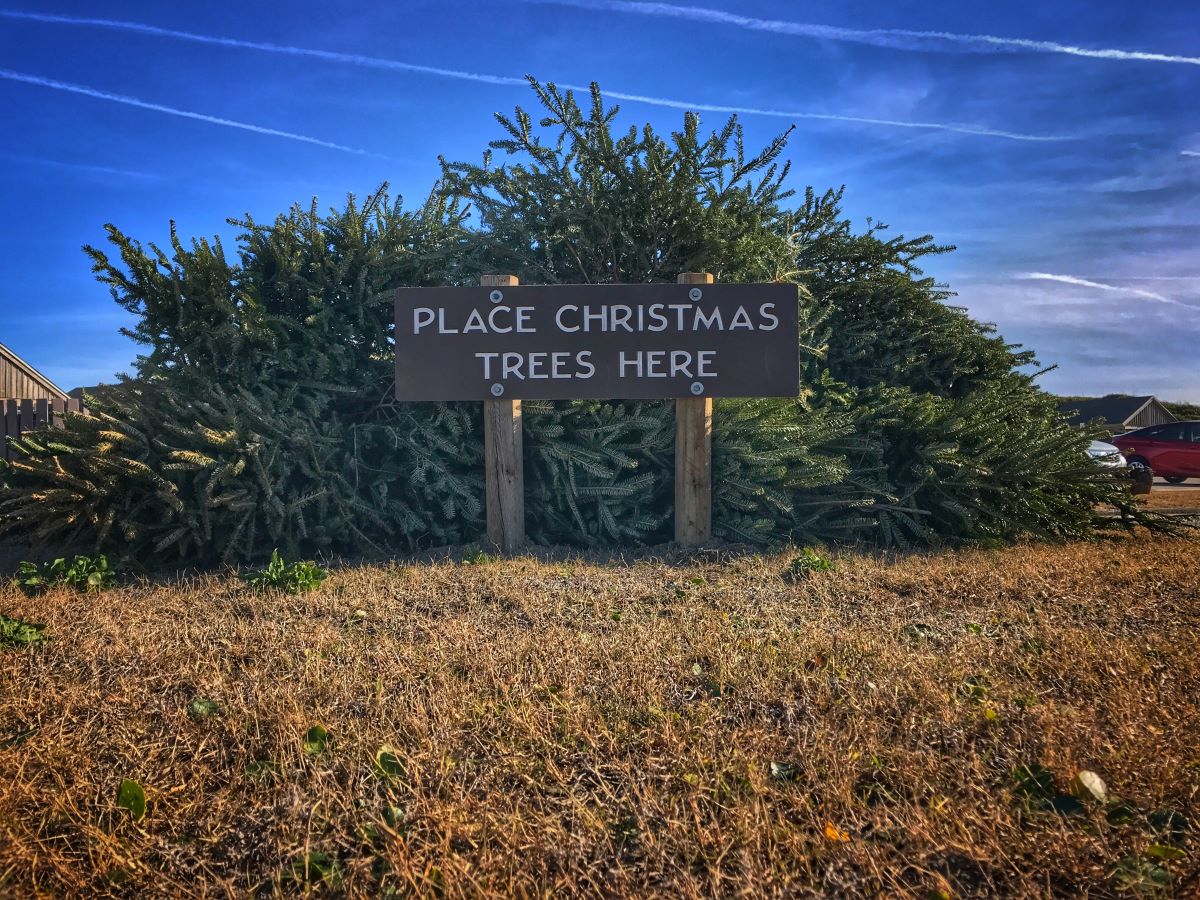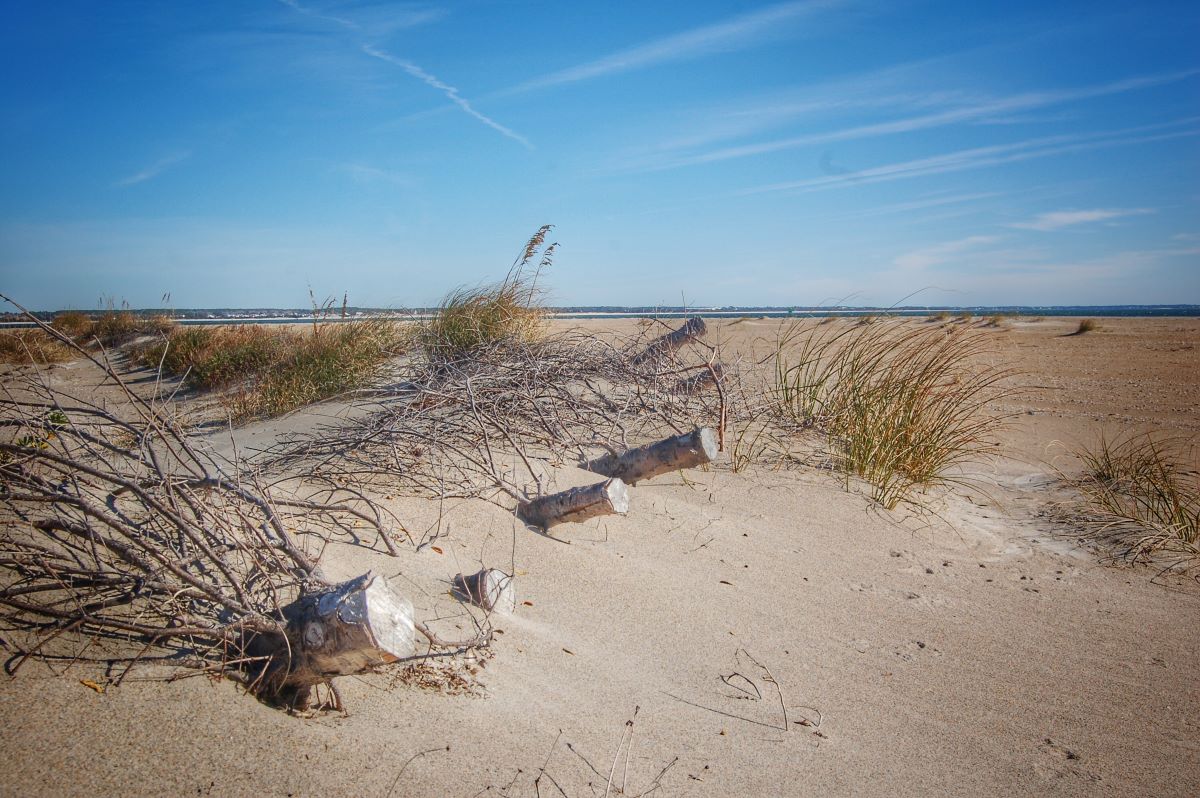
From donating your natural, undecorated Christmas tree for dune restoration projects to dropping it off at a county convenience site to become mulch, there are options when it comes to disposing of a live tree after the holidays.
Fort Macon State Park has relied on natural Christmas trees to help stabilize its dunes since the mid-1960s. Unfortunately, donations have been lower in recent years, Park Ranger Benjamin Fleming said in an interview.
Supporter Spotlight
The state park on Bogue Banks in Carteret County is collecting trees again this year to help with dune stabilization until Feb. 15, but Fleming said they’ll continue to take the trees if they’re dropped off after.
“We really need the trees to help with erosion control. We are still trying to rebuild dunes we lost during Florence,” Fleming said about the 2018 hurricane.
Before dropping off the tree, Fleming said to remember to remove all ornaments and decorations. They find a few ornaments every year that were obviously important and special, like baby pictures, still left on the donated tree. He added that the park can’t use trees covered with silver plastic tinsel because the tinsel blows off the trees into the park or ocean, which makes the park look unkept and kills wildlife.
Businesses should contact the park office at 252-726-3775 before bringing large loads for donation.
At the other end of the Island in Emerald Isle, Surfrider Bogue Banks will be collecting live Christmas trees at the corner of Islander and Emerald drives in now through Feb. 3. The organization will use the undecorated, natural trees to build dunes at the Point, or the westernmost portion of the island.
Supporter Spotlight
Sea Scout Ship and Maritime Explorer Club 7730 will collect trees for a $10 donation and take it to the drop-off area in Emerald Isle. Sign up for pickup at www.seascouts7730.org.
On Feb. 4, Surfrider Bogue Banks will need volunteers to help haul and secure the trees on the beach. Email chair@boguebanks.surfrider.org to RSVP.
Not all beaches need trees though. In some cases, it can cause more harm than good.
Lindsay Addison, coastal biologist with Audubon North Carolina, told Coastal Review that a few years back, they found that people were leaving their old Christmas trees on Lea-Hutaff Island. In some cases, a large number were left.
“This was concerning because we had not asked for trees to be brought to the island and they were not wanted for the island. We removed the trees including some that had washed into the marsh and were smothering the marsh grass and others that were taking up space in a Wilson’s Plover and least tern nesting area. We’ve seen them scattered on other local islands as well, not part of a planned effort,” she said.
Lea-Hutaff Island is a 5,641-acre undeveloped barrier island and marsh system that has remained undisturbed by development, dredged sand and off-road vehicles north of Wilmington between Figure Eight Island and Topsail Island, according to Audubon.
Because Lea-Hutaff is an undeveloped barrier island, Audubon manages the site to be in as natural a state as possible, Addison explained.
“Barrier islands are supposed to move and change. When these natural movements threaten buildings on developed barrier islands, trees are sometimes placed there in the hopes that they will accelerate the regrowth of dunes. However, results are mixed,” Addison said.
Trees can just as easily become coastal or marine debris, even if they are staked down, the dunes they create aren’t always stable, and they can impede the growth of native dune vegetation. The trees also can impede nesting sea turtles or take up habitat that would otherwise be good for nesting birds, Addison said.
“Overall, they really don’t belong in a natural barrier island landscape,” she continued.
When the tree issue first came to Lea-Hutaff, Addison said they looked into pros and cons with the North Carolina Coastal Federation, which publishes Coastal Review, and Coastal Area Management Act, or CAMA, rules.
“Based on that research, we concluded that unless a cost-effective alternative to sand fencing is needed, trees aren’t the way to go. We also learned that unless they are being placed in accordance with sand fencing regulations, they require their own permit from the state,” she said.
In 2021, Addison said Audubon decided to put out signs to keep the problem from repeating itself.
“We had some signs made and planned to put them out around Christmas. Last year was our first year of ‘No Trees, Please,’ and we had no trees left on Lea-Hutaff. We just put out the signs again for this holiday season and we hope we have the same results,” she said.
For people who really want to have their tree go toward dune stabilization, Addison suggested looking for a project organized by a town or agency and make sure they follow state rules.
“Definitely don’t bring your tree to any site that isn’t asking for them. Alternatively, trees make great backyard habitat,” Addison said. Placed in a backyard, they create habitat for wildlife like wrens and sparrows.
Addison also recommended taking the trees to towns or counties that have a mulching program. These programs are great because not all store-bought mulch is responsibly sourced, she said.
The state Division of Coastal Management officials said in a release Monday that rules state that Christmas trees for sand fencing must be placed as far inland as possible and should not obstruct existing public access to the beach, recreational use of the beach or emergency vehicle access. If sand fencing is present, there must be 7 feet separating the trees and sand fencing sections.
For example, trees should be installed at an angle no less than 45 degrees to the shoreline, no more than 10 feet seaward of the toe of the natural dune, and no less than 7 feet between trees, officials said.
Trees should not be installed in a manner that could impede, trap or otherwise endanger sea turtles, nests or hatchlings when the nesting season returns in a few months. Rows should be single tree width and not installed in conjunction with sand fencing. Trees should not be placed at the seaward toe of unvegetated beach berms, starter dunes, or on the open beach.
For more information, contact the Coastal Area Management Act permitting authority or appropriate Division of Coastal Management district office.
Boy Scout Troop 117 on the Outer Banks and Hammocks Beach State Park in Swansboro are not collecting trees this year.

By county
Currituck County has eight convenience centers for recycling and trash collection where live Christmas trees may be dropped off. All decorations will need to be removed from the tree, a county representative told Coastal Review.
Chowan, Gates and Perquimans counties are accepting natural trees in the yard waste containers at any of the convenience sites or at the PCG Transfer Station in Belvidere.
Live Christmas trees will be used in the counties’ composting programs, which turn trees and yard debris into compost and mulch. Compost and mulch produced through these programs are free to community members, said Amy C. Underhill, public information officer for Albemarle Regional Health Services.
Hertford County has a yard waste program. The limbs need to be cut off and the base of the tree has to be less than 6 inches in diameter. The pieces can be dropped off at the Transfer Station at 227 Mt. Moriah Road in Ahoskie.
Washington County will accept trees at the landfill. The trees will be disposed with other limb and leaf debris, which is used as infill material, a county representative said.
Beaufort County will accept natural trees, garland and wreaths at all convenience sites and the county landfill at 1342 Hawkins Beach Road, Washington.
Dare County Public Works Department will not pick up any Christmas trees that are left on the curbside within the unincorporated areas of the county. Christmas trees should be dropped off at the Dare County Public Works Recycling Center at 1018 Driftwood Drive in Manteo or at the Buxton Transfer Station, 47027 Buxton Back Road. Trees that are dropped off at these locations will be recycled into mulch.
Manteo requests that residents place their trees curbside during the town’s regular Monday and Thursday sanitation runs for the Public Works Department to remove the trees. Trees must not contain any ornaments, lights or tinsel in order to be picked up.
Duck will collect trees from the curbside on Monday and again Jan. 9. Trees need to be placed on the curbside the night before residents’ scheduled collection date.
Southern Shores residents may place their Christmas trees in limb and branch piles for collection during the regularly scheduled pickup for their sector. Wreaths will not be collected.
Kitty Hawk officials ask that residents place their Christmas trees along the curbside right-of-way before Wednesday, Feb. 1, to be picked up.
Kill Devil Hills will be collecting trees placed beginning Wednesday, Jan. 11. Trees must be on the curbside by Jan. 10.
Nags Head residents are asked to place trees along the side of the road in front of their property, where the trees will be collected as part of the town’s monthly curbside bulk item/brush collection service. The town also reminds residents to set their trees in a separate pile from the rest of any bulk items that need to be collected.
Onslow County will be accepting natural Christmas trees from Dec. 27 to Jan. 7 at the Midway Park and Folkstone convenience sites only. Cost is $3.
Pender County’s convenience centers in Rocky Point and Hampstead will accept Christmas trees Jan. 2 through Jan. 16.
New Hanover County Recycling and Solid Waste Department has partnered with The Home Depot for free Christmas tree recycling through Jan. 31. Residents can drop their trees off at The Home Depot at 5511 Carolina Beach Road, The Home Depot at 210 Eastwood Road, and at New Hanover County Landfill, 5210 U.S. 421 North.
“Every year, people have natural décor in their homes to celebrate the holiday season, but once the festivities are finished many don’t have anywhere to easily dispose of it,” said New Hanover County Recycling and Solid Waste Director Joe Suleyman in a statement. “This program helps make sure that real Christmas trees, wreaths, and garlands can be recycled into mulch and composted to be used in New Hanover County parks, gardens and grounds. It’s a great way for our community to help reduce waste in our landfill and keep our environment clean.”
Artificial trees or decorations will not be accepted.
Residents are asked to stack the materials neatly because space is limited and organizers expect demand to be high again this year. Fenced-in areas in The Home Depot parking lots will be marked with signage designating the drop-off locations. The program is funded and coordinated by New Hanover County Recycling and Solid Waste, with support from Wilmington Sanitation Department and Home Depot.
In addition to trees and wreaths, items like gift wrap, paper or cardboard boxes, holiday cards, old gadgets and electronics can be recycled at the county’s main recycling processing facility, drop-off sites or through the Mobile Hazwagon.
String lights, tinsel, foam packaging, bubble wrap, and ribbons or bows cannot be processed at the recycling facility and should be saved for reuse or thrown in the trash.
In Brunswick County, live Christmas trees will be accepted at the landfill at no charge from Jan. 2-31. After Jan. 31, normal tipping fees apply. The county convenience sites will accept trees for $5 each from Jan. 2-31. Artificial trees are not recyclable and will need to be disposed of as household trash. Normal tipping fees will apply.
Once the deadline passes, staff will collect all live Christmas trees from convenient sites and add them to the live Christmas tree collection site at the Brunswick County landfill, where the trees will be turned into mulch available at no cost to the public.







